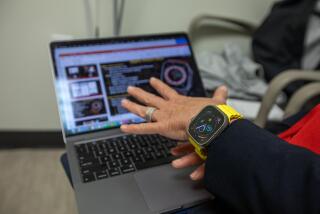Success May Be Heartbeat Away for Fledgling Catheter Maker
- Share via
Michael Henson spends his life talking to heart doctors. He vacations with them. He watches them work. The chief executive said he recently “spent all day in a catheter lab, with my suit off, with greens on, watching cardiologists putting catheters in patients.”
Such attention to detail is one reason the young Irvine company he runs, CardioVascular Dynamics Inc., is experiencing sudden growth. Sales this year are expected to hit $8 million, double 1995’s results. The company, which had all of eight employees 15 months ago, is anticipating a payroll of 200 by year’s end.
The Irvine company might even break off from its Pleasanton, Calif.-based parent, Endosonics Corp., this year and go public, although executives are tight-lipped about those plans.
CardioVascular, which Henson and chief engineer Michael Crocker founded four years ago, makes catheters for treating clogged arteries. The firm’s prized product is a patented catheter with an elongated balloon for angioplasty, which expands more in the midsection than at either end, a feature that limits the damage that can occur to healthy tissue and cause vessels to become clogged again.
Eight of the company’s devices have won federal approval in the last 18 months. Several are already in production, and the remainder should be on the assembly line by the end of the year, executives said. The company has also lined up critical corporate licensing and marketing agreements.
Pieter Halter, president of Medical Data International Inc., an Irvine marketing research firm, lists CardioVascular as one of the few entrepreneurial firms that could be headed for big success. With good management, innovative technology and enough financing through parent Endosonics, he said, the company is on the right track.
Observers predict the company will make an initial public offering this year. Such a move would give CardioVascular shareholders a piece of a rapidly growing company that isn’t bogged down by Endosonics’ sleepier prospects, said Paul Goeld, a competitor who is also a friend of Henson’s.
Henson said the company is “obviously considering” the possibility of an IPO, but when asked to elaborate, he downplayed the idea.
*
Henson and Crocker met in the mid-1980s at Trimedyne Inc., an Irvine maker of medical lasers and related items. Henson, then Trimedyne’s president and chief executive, hired Crocker in 1986 as the engineer in charge of developing catheters.
In 1988, Henson became president and chief executive of Endosonics, which makes intravascular imaging systems and related catheters. He hooked up with Crocker again two years later. Crocker, who had been with a start-up company that flopped, was designing catheters in his kitchen and dreaming of starting a company.
Henson was still running Endosonics, but the two formed CardioVascular Dynamics in 1992. A year later, Endosonics bought the fledgling catheter maker. Last year, Henson stepped down as Endosonics CEO to devote himself to the subsidiary.
“Both companies needed someone to run them day to day, and I wasn’t doing justice to either one,” said Henson, who remains chairman of Endosonics.
Like so many young high-tech firms, the company hasn’t hit on a blockbuster product. Researchers have yet to prove its catheter works better than anything else for implanting a stent in a coronary artery wall, which prevents the wall from collapsing.
Dr. Gregg W. Stone, a cardiologist at Stanford University Medical Center, is running clinical trials to see whether the catheter does a superior job of deploying stents. In the next few months, patients will be tested at six laboratories nationwide.
A more immediate challenge is manufacturing the catheters already approved. With cardiologists extremely picky about what they’re willing to implant, the company takes pains to make sure its catheters cut the mustard. To help ensure quality, CardioVascular is offering stock options to anybody, including assemblers, who has worked at the company a year or more.
Its future also depends on distribution, increasingly a barrier to growth for small companies that work a limited niche in the health-care world.
More to Read
Inside the business of entertainment
The Wide Shot brings you news, analysis and insights on everything from streaming wars to production — and what it all means for the future.
You may occasionally receive promotional content from the Los Angeles Times.










